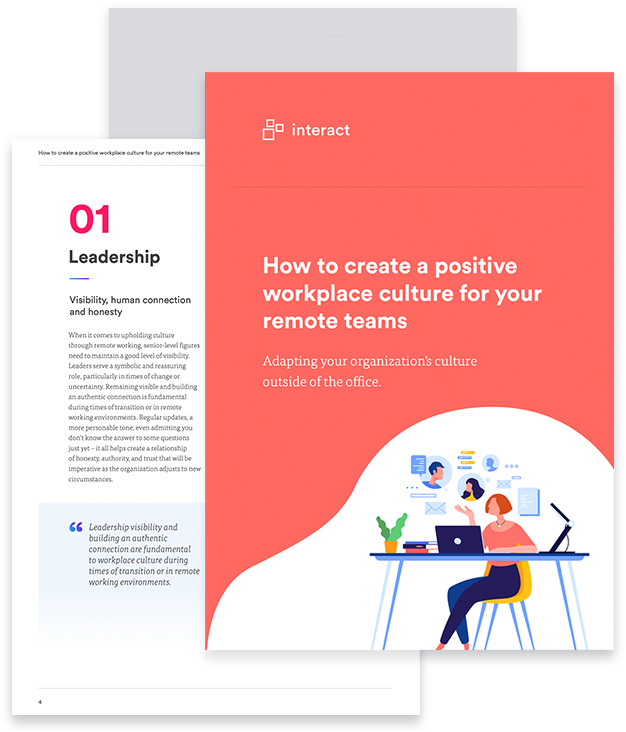Remote working, telecommuting, flexible working – thanks to the wonders of technology, we’re increasingly finding new ways to get the job done.
We can shape our own work experiences. We can cut out the nightmare commute and work intuitively to our own rhythm, energy levels and timetables. Apparently, we really can have it all – the home life, and the office life, perfectly balanced.
Maintaining company culture whilst working remotely
It’s a growing trend, tipped to be “one of the biggest drivers of transformation in the workplace”, according to the World Economic Forum. In fact, Gallup’s State of the American Workplace report found 43 percent of Americans spent at least some time working remotely last year, up from 39 percent in 2012.
However, how do you ensure you reap the maximum benefits – both as an individual working remotely, and as an organization hiring a dispersed workforce?
If your business is rolling out a flexible, telecommuting or remote working model, it’s worth confronting – and make contingencies for – the biggest disadvantages of remote work, for both employer and employee.
What are the biggest challenges facing remote employees?
The biggest challenges facing remote employees include:
- The impact on organizational culture and individual well-being
- Accountability and visibility
- Security – both physical, and digital
- Maintaining boundaries between work life and home life
- Time zone and communication difficulties
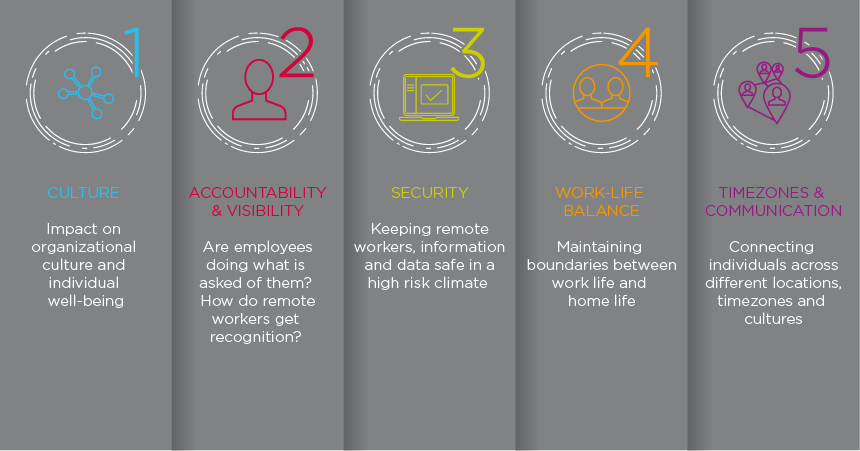
Failure to address these causes decreased productivity and employee engagement, an impact on overall team morale, increased staff turnover, and a negative impact on business outcomes.
Let’s explore those a bit further.
#1 Impact on organizational culture
Many remote workers say the lack of community and a disconnect from the overall company culture as one of the biggest downfalls.
There are fewer opportunities to connect and engage with their peers, resulting in a lack of that much-valued sense of ‘camaraderie’ many office workers experience. There’s also a lack of visibility of the overall business direction, mission and values.
The result is more than a few reports of remote workers experiencing isolation, loneliness and dissatisfaction with their roles. That lack of ‘connection’ with a business is also linked to lower levels of reliability and retention. If your remote workers don’t build loyalties to the organization, they are more likely to move onto new opportunities.
Don’t ignore the importance of actively building a sense of culture for remote employees. Consider bringing everyone together once or twice a year and make use of video conferencing or virtual meetings that use facetime to encourage those connections. By seeing their peers, remote workers can build interpersonal relationships and communicate better, using non-verbal cues.
Use social tools or your company intranet to provide updates and insights into your culture, including your company vision and values, business updates, sharing of success or employee recognition, and day-to-day ‘office conversations’ to ensure that sense of inclusion.
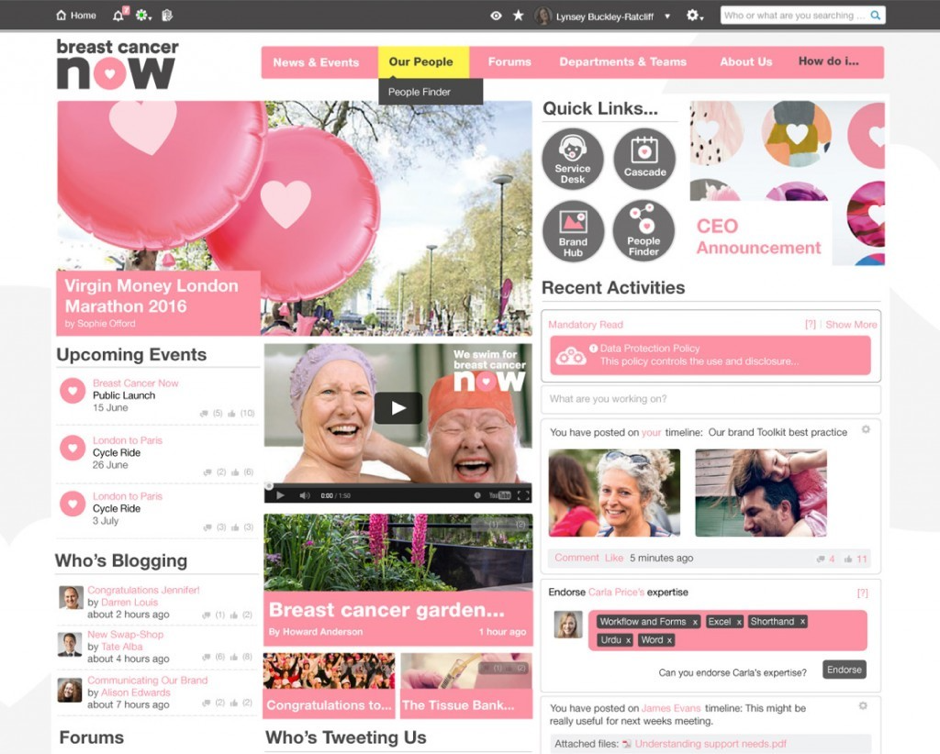
(Nonprofit Breast Cancer Now uses its company intranet to share news, celebrate individual and organizational success, and connect its employees – using social features such as the blog and timeline, alongside extensive use of its own brand, to create a virtual culture for all)
Maintaining company culture whilst working remotely
#2 Accountability and visibility
Then, there’s management and accountability concerns.
As a manager, how do you know if your remote workers are actually doing what’s being asked of them? How do you balance the need for transparency and ‘checking in’, with the threat of becoming a Big Brother-style organization that causes resentment from employees who feel excessively checked up on?
On the other end of the scale, the need to be visible and show productivity can result in remote employees over-working and doing more hours than their in-house counterparts. As self-managers, they often face difficulties in prioritizing work and gaining insight into bigger picture business priorities or objectives.
It’s a process that can result in burn-out, dissatisfaction and ultimately, staff turnover.
Working from home can result in longer hours, more intense work, greater levels of interference and stress, Zapier argue.
Without that visibility and physical presence, remote employees are also more likely to miss out on the day-to-day recognition awarded to in-office employees.
Solve this one by clearly defining expectations and deliverables, with benchmarks or check-in points for employee and manager to discuss progress and achievements. Use of centralized, digital collaboration or project management tools gives greater visibility of where individuals are up to, and their work.
For example, a dedicated team area within your intranet can be used to communicate and collaborate with other team members; to share updates, documents or other deliverables; or to display calendars and ask for input, ideas and assistance.
In addition, social platforms or intranets facilitate peer-to-peer recognition, ensuring even remotely-based employees are visible and celebrated in a public arena.
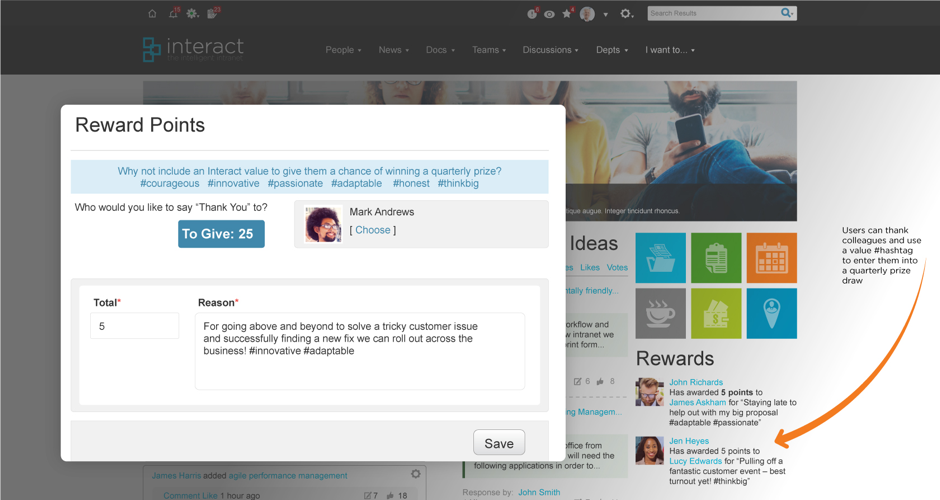
For some organizations, employee monitoring tools are an option; but the use of these should be considered and managed carefully, with transparency and trust between employer and employee to avoid the feeling of ‘spying’ or intrusion. Giving employees breathing space and trust is more likely to deliver positive results.
#3 Security
In an age of global hacks, cyber terrorism and in fact, physical terror attacks, the question of how to keep our employees, our data, and our information safe, is at the forefront of everyone’s minds.
In the office, we have protocols, procedures and policies covering everything from virus protection and password policy through to fire evacuation or what to do when working alone in the office.
Some of these are still relevant. However, remote employees encounter an entirely different set of risks when working in shared spaces, home alone, or even accessing business systems on public networks.
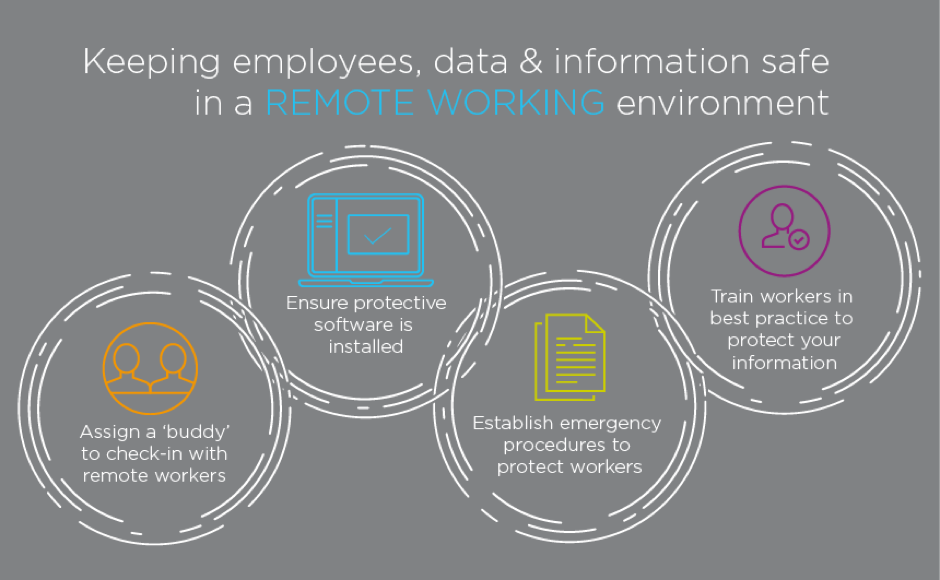
Assign a dedicated ‘buddy’ for your remote employees, whose responsibility is to informally ‘check in’ and ensure the physical – and emotional – well-being of their colleague.
Establish emergency ‘check-in’ protocols in case of a physical disaster or crisis – for example, a natural disaster such as an earthquake, or a threat to the public such as a terrorist attack. Your employees may not be physically in your office space, but they remain your responsibility.
Finally, work with IT to build a culture of security for your business. Establish best practices for accessing, and protecting, your information – as well as unifying global workers. Ensure remote workers are fully trained on information security and have the necessary protective software, such as virus protection, installed. If they require access to privileged data or information, ensure you are complying with any legislation and consider an encrypted process to reduce risk.
#4 Work-life boundaries
Improved work-life balance is usually cited as one of the major incentives, and benefits of, working from home. However, it’s not a given.
Remote workers are more likely to be subject to home interruptions, and a blurring between work and home life. We saw this comically demonstrated in a BBC televised interview fail, which saw Professor Robert Kelly accidentally interrupted at a key moment.
Without physical boundaries between a work environment and home environment, this can result in longer or unpredictable hours worked, increased stress, a strain on personal and professional relationships, and the threat of one, or both, sides taking advantage.
Scenario: you’ve asked your boss for flexibility to attend your kid’s soccer game during the day. They say yes. The problem is, in ‘return’, they may not feel guilty calling you at 9pm with a last-minute request. In the world of remote work, it can be tricky to fully switch off.
For the employer, there’s always the worry that staff are taking this as an invitation to fire up Netflix, or that their ideal schedules won’t match up to business needs. If your clients are expecting a 5 day, 9-5 service and your employees are working 4 days, 11-7, how do you reach a balance?
Step one: hire a remote worker. Yes, there is a difference. If you are rolling out remote working for existing in-house workers, they need additional training and support to manage their time, productivity and ability to meet expectations. Individuals who have experience telecommuting are better equipped to meet these challenges.
Be clear in expectations and consider establishing a ‘signal’ or protocol to show when employees are working – whether it’s a status on Skype, or simply alerting the manager “I’m logging off now”, to reduce out-of-hours interruptions. For the remote worker, it can also help to set up a dedicated workspace, whether at home or externally, to create a physical boundary between the two.
Maintaining company culture whilst working remotely
#5 Time zone bingo and communication concerns
One of the greatest difficulties experienced by remote or dispersed teams is the question of communication.
If you have individuals working across different time zones or even different countries, you have logistical challenges. What if your employees don’t speak the same language? Could political, cultural or social differences cause difficulties or unforeseen divisions? If your remote workers are based across different time zones, how do you coordinate them?
Remote workers will also communicate over various digital channels. There’s instant messaging, video calls, Skype, project management tools, forums and of course the fail-safe email. That’s a LOT of streams to keep on top of.
The result is misunderstandings, a lack of clarity, and an impact on how individuals build and maintain trust with their colleagues. It also adds to that feeling of isolation from the business – of being ‘out the loop’ compared to peers.
Try to streamline and remove barriers to communication. Use of real-time social tools and weekly video or phone meetings gives workers a chance to connect. Managers need to reach out daily, even informally, to give workers the chance to ask questions or receive support.
I’d also recommend cutting down on email – even eliminating it altogether. Instead, try out more collaborative styles of communicating. Team areas within an intranet combine a mixture of social collaboration tools such as blogs, pages, forums, calendars, galleries, task lists, and a timeline in a centralized, shared environment.
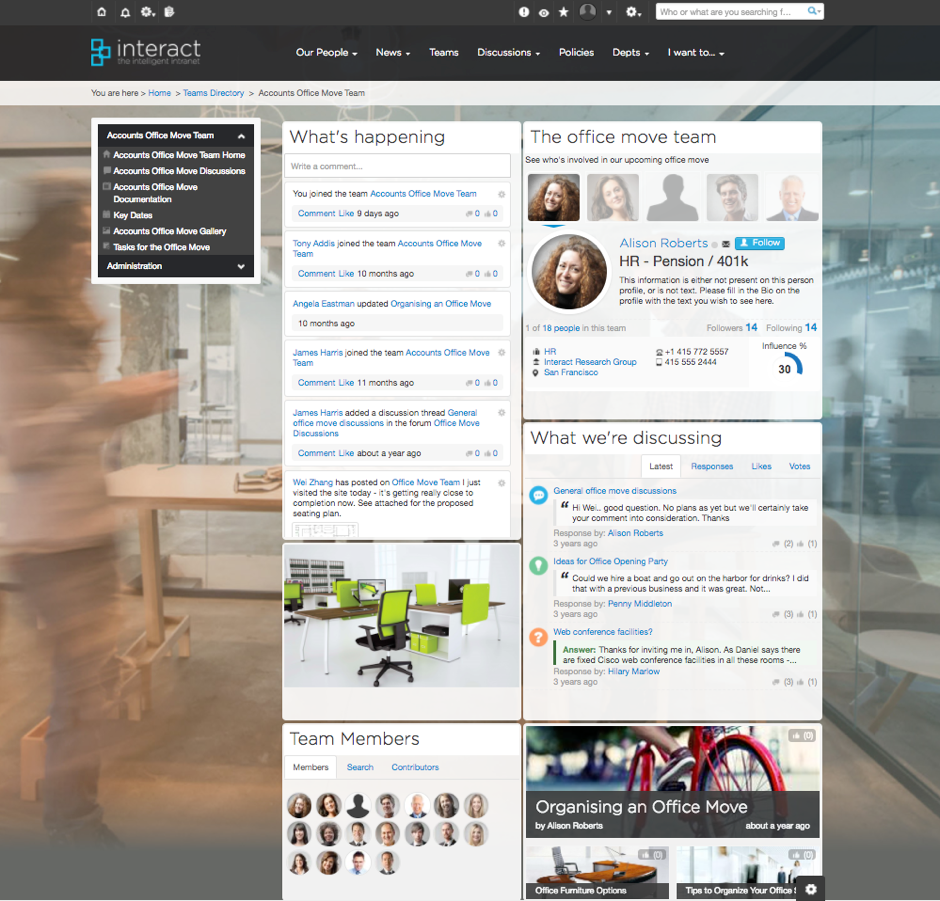
(Dedicated team areas within an intranet can go beyond departments, and be used for any project, event, topic or shared interest. In this ‘office move’ project team, we can see a range of social tools – a timeline for real-time updates, a gallery, blogs, and discussion or idea forums, alongside clear visibility of the team. This creates an online community, connected around a common purpose – idea for remote workers.)
Finally, back up all these channels with an effective enterprise search – this helps employees navigate the digital noise. This not only promotes transparency and supports staff to work more efficiently together, but will increase innovation and problem solving, by bringing together knowledge and skill sets.
Is remote working a win-win?
Undeniably, remote working is increasing in popularity for a reason.
There are plenty of posts, reports and anecdotes championing the benefits of remote working for employees. Research also increasingly shows the numerous ways organizations can benefit from making the move to remote, spanning increased productivity to reduced overheads and more.
82 percent of telecommuters report lower stress levels, while two-thirds of managers surveyed by SurePayroll say employees who work remotely increase their overall productivity.
Talent shortages or skill gaps in regional locations are also making remote working an attractive option for those charged with recruiting responsibility, by opening up the talent pool and removing traditional joining barriers or objections.
It’s an approach that has worked for many. Automattic, creator of WordPress, is one of the great examples of a distributed company that has capitalized on both the need to source great talent outside the traditional ‘tech hubs’ of Silicon Valley or New York, and the demand for flexibility being voiced by employees. Employees are equipped with “the best equipment possible”, a $2,000 home office allowance and given opportunities to travel for ‘hack weeks’ around the world.
But is everything in the garden of remote working rosy? Like any organizational ‘shift’, there are some undeniable challenges and considerations. For every positive story, there’s a scare story to match it. In 2013, Yahoo went so far as to ban working from home outright: “We need to be one Yahoo!, and that starts with physically being together,” read the internal memo from HR head at the time, Jackie Reses.
Like any significant business change, it comes down to a simple idea: risk management. If you identify, and take steps to reduce, potential risk, you’re far more likely to see success.
